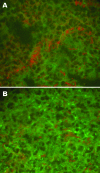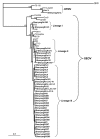Seoul virus and hantavirus disease, Shenyang, People's Republic of China
- PMID: 19193263
- PMCID: PMC2662651
- DOI: 10.3201/eid1502.080291
Seoul virus and hantavirus disease, Shenyang, People's Republic of China
Abstract
An outbreak of hemorrhagic fever with renal syndrome (HFRS) occurred among students in Shenyang Pharmaceutical University in 2006. We conducted a study to characterize etiologic agents of the outbreaks and clarify the origin of hantaviruses causing infections in humans and laboratory animals. Immunoglobulin (Ig) M or IgG antibodies against Seoul virus (SEOV) were detected in the serum samples of all 8 patients. IgG antibodies against hantavirus were also identified in laboratory rats, which were used by these students for their scientific research. Phylogenetic analysis showed that partial small segment sequences recovered from humans, laboratory rats, and local wild rats belonged to SEOV. Hantavirus sequences recovered from humans and laboratory rats clustered within 1 of 3 lineages of SEOV circulating among local wild rats in Shenyang. These results suggest that the HFRS outbreak in Shenyang was caused by SEOV that was circulating among local wild rats and had also infected the laboratory rats.
Figures


Similar articles
-
Seoul Virus Infection and Spread in United States Home-Based Ratteries: Rat and Human Testing Results From a Multistate Outbreak Investigation.J Infect Dis. 2020 Sep 14;222(8):1311-1319. doi: 10.1093/infdis/jiaa307. J Infect Dis. 2020. PMID: 32484879
-
Serological and genetic evidence for the presence of Seoul hantavirus in Rattus norvegicus in Flanders, Belgium.Scand J Infect Dis. 2009;41(1):51-6. doi: 10.1080/00365540802459994. Scand J Infect Dis. 2009. PMID: 18821445
-
Hantaviruses in rodents and humans, Inner Mongolia Autonomous Region, China.Emerg Infect Dis. 2009 Jun;15(6):885-91. doi: 10.3201/eid1506.081126. Emerg Infect Dis. 2009. PMID: 19523286 Free PMC article.
-
Wild Rats, Laboratory Rats, Pet Rats: Global Seoul Hantavirus Disease Revisited.Viruses. 2019 Jul 17;11(7):652. doi: 10.3390/v11070652. Viruses. 2019. PMID: 31319534 Free PMC article. Review.
-
Seoul hantavirus in brown rats in the Netherlands: implications for physicians--Epidemiology, clinical aspects, treatment and diagnostics.Neth J Med. 2015 May;73(4):155-60. Neth J Med. 2015. PMID: 25968286 Review.
Cited by
-
Recurrent Occupational Hantavirus Infections Linked to Feeder Rodent Breeding Farm, Taiwan, 2022.Emerg Infect Dis. 2024 Aug;30(8):1702-1705. doi: 10.3201/eid3008.230875. Emerg Infect Dis. 2024. PMID: 39043457 Free PMC article.
-
Co-circulation of multiple hemorrhagic fever diseases with distinct clinical characteristics in Dandong, China.PLoS One. 2014 Feb 27;9(2):e89896. doi: 10.1371/journal.pone.0089896. eCollection 2014. PLoS One. 2014. PMID: 24587107 Free PMC article.
-
Immunopathogenesis of Different Emerging Viral Infections: Evasion, Fatal Mechanism, and Prevention.Front Immunol. 2021 Jul 15;12:690976. doi: 10.3389/fimmu.2021.690976. eCollection 2021. Front Immunol. 2021. PMID: 34335596 Free PMC article. Review.
-
Investigating the effects of climatic variables and reservoir on the incidence of hemorrhagic fever with renal syndrome in Huludao City, China: a 17-year data analysis based on structure equation model.BMC Infect Dis. 2009 Jul 8;9:109. doi: 10.1186/1471-2334-9-109. BMC Infect Dis. 2009. PMID: 19583875 Free PMC article.
-
Migration of Norway rats resulted in the worldwide distribution of Seoul hantavirus today.J Virol. 2012 Jan;86(2):972-81. doi: 10.1128/JVI.00725-11. Epub 2011 Nov 16. J Virol. 2012. PMID: 22090114 Free PMC article.
References
-
- Childs JE, Glass GE, Korch GW, LeDuc JW. Effects of hantaviral infection on survival, growth and fertility in wild rat (Rattus norvegicus) populations of Baltimore, Maryland. J Wildl Dis. 1989;25:469–76. - PubMed
-
- Chen HX, Qiu FX, Dong BJ, Ji SZ, Li YT, Wang Y, et al. Epidemiological studies on hemorrhagic fever with renal syndrome in China. J Infect Dis. 1986;154:394–8. - PubMed
-
- Zhang YZ, Xiao DL, Wang Y, Wang HX, Sun L, Tao XX, et al. The epidemic characteristics and preventive measures of hemorrhagic fever with syndromes in China [in Chinese]. Zhonghua Liu Xing Bing Xue Za Zhi. 2004;25:466–9. - PubMed
Publication types
MeSH terms
Substances
LinkOut - more resources
Full Text Sources
Molecular Biology Databases
